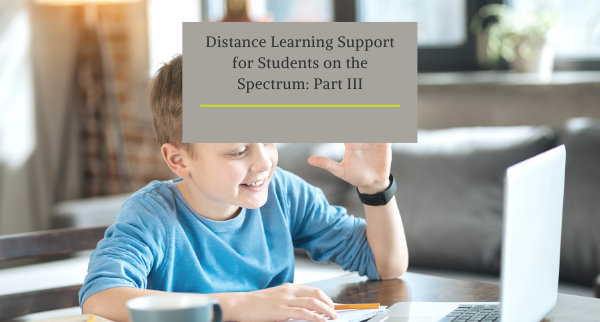Distance Learning Support for Students on the Spectrum: Part III
In addition to building strong relationships and maintaining consistency, students with autism who are struggling more than usual due to distance learning will also greatly benefit from specificity. Below are additional strategies that educators can use to help best support their students on the spectrum while we continue with virtual learning.
Make everything as specific as possible
When it comes to Zoom class sessions and online learning in general, teachers sometimes forget that students are not hanging on our every word like they would be more inclined to do in the physical classroom. Since Zoom meetings are often a passive form of learning—even when we try our hardest to keep it engaging—students, especially those with autism, are probably not absorbing every major point, example, instruction, etc. Because of this, students require significantly more repetition, clarification, and specificity to succeed with virtual learning. Teachers should consider taking the following steps to ensure that instruction, assignments, directions and tasks are as specific as possible:
- When assigning reading homework, teachers should be careful to phrase the chapters and pages very specifically. For instance, when saying, “Please read chapters 1-3,” some students may interpret that to mean read up to chapter 3, not including it. Be sure to clarify specifically what page number students should stop reading for a particular assignment to avoid this miscommunication.
- As discussed in part two, naming or labeling assignments and resources consistently is key to streamlining materials for students. The same is true regarding specificity. Titling an assignment “Writing Homework #1” is too vague. This name does not help students to identify the details of the task when looking at Canvas. Remember, students have anywhere from 5-7 classes; therefore, specifically titling tasks in Canvas or other virtual portals will help trigger their memories and clarify the exact task that you are asking them to complete.
- Provide specific times for assignment submission as well. Canvas allows you to just set a due date; however, some students may appreciate having a specific cut off time for submitting an assignment just to be sure. For example, I always set the time to 11:59pm whatever day the task is due. This way, students know that they always have that final full day to complete and submit without penalty.
- Consider providing students with a reference sheet that specifies what you mean when you say certain high-frequency, tier 2 and 3 vocabulary terms in class. Abstract words, such as analyze, evaluate, critique, and assess can cause stress and uncertainty for students with autism. Accompany these terms with specific examples and explanations so that students know exactly what is expected of them. This is a great practice for all students, especially when teachers are introducing key unit questions, objectives, and writing prompts.
When providing written feedback, especially since virtual learning leaves less time for 1:1 conferences and writing workshops, it is especially helpful for teachers to use a higher level of specificity. If students are not able to directly connect a teacher’s feedback to an area of weakness and how they can strengthen that weakness in the next assignment, then the feedback is essentially worthless. One worthwhile activity to gauge whether or not your feedback is specific enough is to ask students to reflect on the feedback that they received on an essay or project. This ensures that 1) they have actually read the feedback, and 2) that they fully comprehended their errors and areas for improvement.






